Editorial: Save the Day
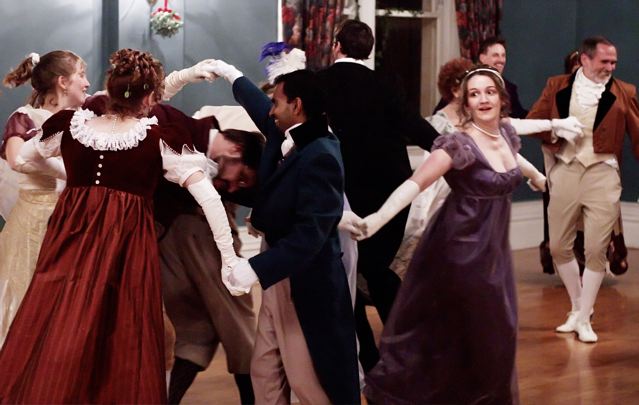
It may come as a surprise to some that there was a period in the nineteenth century in which the survival of Christmas in urban life was doubtful. For centuries in Europe it had been a village celebration extending over several days or weeks, a combination of Christian and pagan religious images, ideas, and practices, varying from place to place, at once changing and relatively stable. But as a result of the mass migrations to cities caused by the industrial revolution and other factors in the late eighteenth and early nineteenth centuries, many people became rootless, losing much of the extended-family and village culture that had given meaning to their lives. And Christmas observance seemed among the many elements of their past life about to erode away. In Dickens' 1843 Christmas Carol, set in such an industrial city, we see that both Bob Cratchit's notorious employer Scrooge, and his daughter Martha's employer, are reluctant to give them even one full day off to celebrate--forget about twelve days. It's not good business.
Dickens' Christmas
The portrayal of Christmas in the Carol by those unbusinesslike people who still keep it differs significantly from the main emphases today. Present-giving is a relatively minor theme in the novella: we see it in only one scene, in which the husband of Scrooge's former fiancée Belle comes home with toys for their children. Christmas giving centers rather on sharing one's bounty in the form of donations of food and money to help the poor; it is part and parcel of the major theme of warmth and abundance for all. Dickens' Christmas means families and friends and perhaps abused apprentices from down the street gathering to play children's games, dance, feast, and sing around roaring fires that defy the darkness and the cold. Little is said explicitly about the Bethlehem stories, but the theme of the Child--vulnerable yet life-giving and joy-giving--permeates the story, whose plot climaxes with Scrooge's transformation on Christmas morning, as he turns somersaults and compares himself to a newborn baby.
Unhappily, the themes of new life, conviviality, and joy do not extend to our animal cousins, who have cameo roles as draught-slaves or fur trim on clothing, and "starring" roles as corpses being devoured. The big to-do about Scrooge's anonymous gift of a giant turkey-carcass to the Cratchits--happily given and ecstatically received--is of a piece with the charnel-house array among the tasty items of real food at the feet of the Ghost of Christmas Present. "[T]urkeys, geese, game, poultry, brawn, great joints of meat, sucking-pigs, long wreaths of sausages . . . ." together with the apples, oranges, nuts, cakes, and steaming punch, are all expected to whet one's appetite for the feast. They are more likely to create confused responses in awakened readers, who, in the midst of their applause for generosity and fun, will shudder at these reminders of merciless violence against the defenseless. Dickens' Christmas is indeed "a kind, forgiving, charitable, pleasant time," but also--as the bereaved goose cries out in Babe--"Christmas is carnage!"
Death, New Life, and Animals
As familiar as the story is, its looming themes of death and ghosts are not what we tend to associate with Christmas. But the fact is that traditionally Christmastide, and Yule before it, were seen as one of the in-between periods of the year, the boundary times (like midnight) when the borders between worlds grew thin and porous. Both unquiet ghosts and powerful angels (and perhaps pixies, elves, elementals et al.) were close at hand, and likely to be involved in human affairs. Most humans might not see them, and a few did not believe in them; but ghost stories told around the fire--with accompanying shivers of fear, delight, or both--were long one of the staples of the season.
A quick survey of Christian customs of Christmastide from former centuries, and their pagan forbears, suggests not only that animal themes are persistent, but that this duality--violence and/or death on the one hand, awe and joy in the presence of Something life-giving on the other--appears in the animal theme itself. On the grim side: St. Martin's Day in November was once a time not only of bonfires and feasting but of killing enslaved animals--cattle, pigs, geese--sometimes sprinkling their blood on the threshold. St. Andrew's day some weeks later was celebrated by hunting, killing, and feasting on squirrels. A medieval Christmas practice involved a pack of young men, their faces blackened, going out with cudgels to find and kill a wren, whose feathers would be shared out among the villagers, and his or her body ceremonially buried. Ordinarily the wren was considered to be sacred, so the event, intended to bring good luck for the coming year, clearly partook of the nature of sacrifice. A distant ancestor of our benign Santa Claus with his reindeer-drawn sleigh and elves (via his grandfather, St. Nicholas on his white horse) seems to have been the Norse God Odin on his powerful eight-legged horse, accompanied by his hound, leading across the sky the feared Wild Hunt that draws in the ghosts of the dead--the same Odin to whom horses were sacrificed.
But other Christmas themes presented animals as participating in the Edenic harmony that touched earth at this sacred time. A medieval legend has ordinary stabled animals gaining the ability to speak on Christmas Eve midnight, as they participate in the power of history's pivotal Event in the Bethlehem stable. A variant of this idea appears in a pictured scene of forest animals, on that same night, all lying harmoniously together in a Peaceable Kingdom. The quotation from Hamlet in this month's Poetry section gives another such picture of supernatural Christmastide wonder and power manifesting in a bird's song. A further echo of this theme appears in Thomas Hardy's "The Darkling Thrush," whose song, so joyous amidst the bleak, dying landscape, seems to express some "blessed Hope" the human narrator does not know.
Thus in the tradition we humans are simultaneously telling animals "You are beings spiritually attuned, perhaps even more deeply than we, to God's lifegiving work among us," and "You are mere things, to be crushed and devoured, in order to heighten the pleasures and the energy of the festival." Something here doesn't quite fit! At one time the sacrificial element made a meaningful connection, since violent sacrifice has long been thought to bring about renewal. But it is very hard to establish that this does indeed work--and there is much evidence that violence leads to psychic numbing and more violence. The killing of animals today, however, is not even sacrificial, but is done explicitly for the sake of perceived human pleasure.
To Purify Christmas
Animal defenders have been trying to be heard on this issue for a considerable time, but unfortunately, our message tends to be classed with that of Christmas critics of yesteryear, specifically, Puritans and, yes,
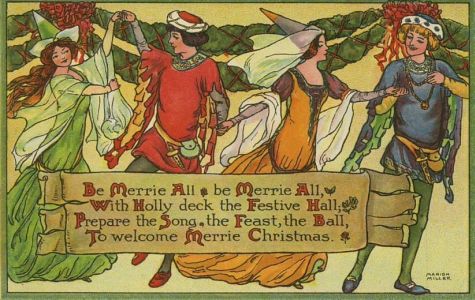
Quakers. Both saw serious problems (such as pagan roots, carousing excesses, and immoral behavior) with Christmas celebrations; sadly, the bloodshed involved wasn't among their complaints. Their solution was to wipe the day off their calendars altogether. Early Quakers' objections to Christmas have long passed out of general notice, but Puritanism is, somewhat unfairly, still equated with a joykilling asceticism that defenders of flesh-eating are ready to find in the motivations of animal defenders, whether it is really there or not.
It helps if we acknowledge that their objections to our critique of Christmas probably have a deeper basis than taste buds. Anything that sounds like an attempt to demolish a holiday/holy-day is likely to awaken profound anxieties that one's roots are being cut, that the meaningfulness of one's way of life, indeed, one's whole spiritual/cultural world, is under threat. (More about this in a later PT.)
What we seek to end is, of course, not Christmas or any other celebration, but the institution of animal slavery and killing that stains it. That change is even more radical, but we know that, far from destroying our whole cultural world, it would in fact help to save it from the ecological menace that hangs over us, and probably hasten spiritual evolution as well. But if we are to make headway in our attempts to bring about such genuine, compassionate, life-giving change, it is important that we work to defuse people's anxieties about losing Christmas and all that such celebrations mean to them. Those of us of who are Christian do well to accompany our message of a cruelty-free meal by actively affirming all that is positive in our tradition (implicitly supporting, not putting down, other faiths). Unlike so many aspects of abolitionism , this affirming work is a joy.
Reclaiming Christmas Treasures
The Christmas Carol itself offers us concrete suggestions here. The feast will always be important: vegetarianism does not mean scarcity, as many fear, but greater abundance, with greater aliveness. Furthermore, by ending its violence, abolitionists of Christian roots are affirming the life-giving side of the Christmas animal-theme, in particular, the founding story of the beasts in the stable standing in awe around the holy Child. We are also finding unsuspected depths inherent in the angelic blessing "Peace on Earth." Our present culture's unbalanced emphasis on individual gift-giving can be limited by a firm spending cap (the economic recession has already effected this for many), and instead stressing charitable giving and what might be called justice-giving, as shown in the story. Exploitation, neediness and suffering have certainly not gone away since 1843.
But we also need to have fun, as the Cratchit family, Fred and his wife and friends, and Fezziwig and his family and protégés all did at their parties. And fun need not cost much. We can go back to playing intergenerational games, whether they be the blind-man's-buff that the Cratchits and Fred's friends played, musical chairs, charades, or whatever memory calls up. (At my home Meeting we play such games each fall to kick off the First-Day school year; it's energizing and enjoyable for all ages.) If a large space 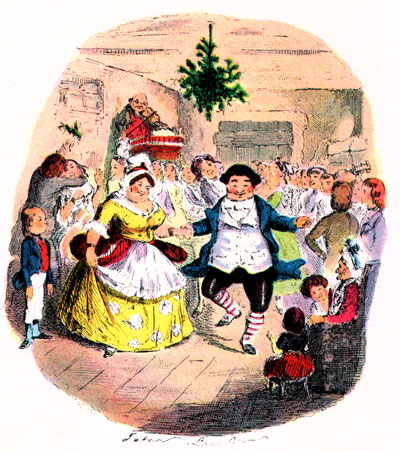 is available, group dancing is a wonderful way to celebrate, and many circle dances are easy to learn. "Sir Roger de Coverley," the line dance happily if clumsily done at Fezziwig's ball, is quickly learned: see instructions at Sir Roger , and a clip of the dance being performed at Dance . Singing carols around the fire as the Cratchits did is another joyous thing--and if the party site is uncooperative, one can always do without the fire!
is available, group dancing is a wonderful way to celebrate, and many circle dances are easy to learn. "Sir Roger de Coverley," the line dance happily if clumsily done at Fezziwig's ball, is quickly learned: see instructions at Sir Roger , and a clip of the dance being performed at Dance . Singing carols around the fire as the Cratchits did is another joyous thing--and if the party site is uncooperative, one can always do without the fire!
We have seen that the tradition of telling ghost stories is represented in the whole plot of the Carol; but the Carol is really more an angel story. It involves Marley and other unhappy ghosts, to be sure, but centers on the three powerful, angel-like Ghosts of Christmas Past, Present, and Yet to Come, who all (even the fearsome third one) appear with the compassionate purpose of offering a life-transformation to Scrooge. This story-telling element can be be revived in the form of telling present-day angel stories, of which many have become available, in print and online, in recent years. Those present may be pleasantly surprised to find that one or another of the guests have their own personal angel story to share.
Bringing new life to these old forms of merrymaking is important not only for the sake of an effective message, but for our own sakes as well. To celebrate the gifts of light and warmth and plenty in the (Northern Hemisphere's) darkest and coldest time of the year can awaken the Joy so deep that it may, as Tolkien says, lead to tears--"Joy beyond the walls of the world, poignant as grief." The new life from Elsewhere is brought into the here and now. Such celebration asserts that the infinite ocean of Love and Light flows over the ocean of darkness and death.
--Gracia Fay Ellwood
Sources: The Book of Christmas by Brendan LeHane (The Enchanted World series), and A Christmas Carol by Charles Dickens.
Unset Gems
To God belong the East and the West:
Whichever way you look, there is the Face of God.
--The Qur'an
"We are the most dangerous species of life on the planet, and every other species, even the earth itself, has cause to fear our power to exterminate. But we are also the only species which, when it chooses to do so, will go to great effort to save what it might destroy." ~Wallace Stegner in This is Dinosaur
--Contributed by Lorena Mucke
"The question is not 'can you make a difference?' You already do make a difference. It's just a matter of what kind of difference you want to make during your life on this planet."~ Julia Butterfly Hill
--Contributed by Lorena Mucke
News Notes
Remembering Animals Lost in War
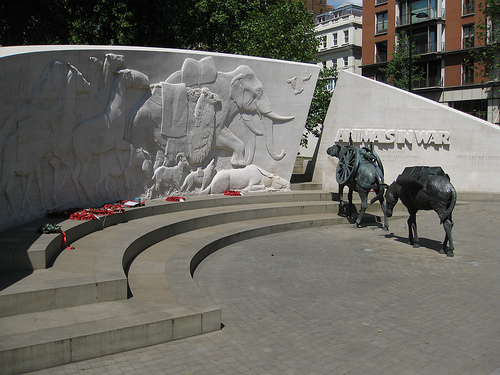
The work , suffering, and deaths in war of millions of non-human animals, such as dogs, equines and pigeons is largely overlooked. In WWI alone, more than eight million horses died carrying troops, supplies and arms into battle. An exception to this common forgetfulness is the Animals in War Memorial at Park Lane in London. On Remembrance Sunday (corresponding to Veterans' Day), some 85 people attended an Anglican service there, led by Pastor James Thompson (the "Animal Padre"), after which flower wreaths from animal charities and individuals were laid.
Uniting in spirit with them, Quaker Concern for Animals and Catholic Concern for Animals, with the endorsement of some Christian clergy and two Jain groups, bore loving witness to all the non-human animals who continue to die as a consequence of war, by laying wreaths of purple poppies at the Remembrance Service on November 8th in Warrington, Cheshire.
--Contributed by Marian Hussenbux, QCA
Rescue of 700 Cats
There are many people in China and Korea who see no more problem with eating cats or dogs than most Westerners do with eating chickens or cows. But increasingly, some Asians are banding together to protest the kidnapping and killing of these stray or companion animals for food or fur. Recently a Chinese group has succeeded in rescuing several hundreds of stolen cats; furthermore, they are beginning to get support from the police. The most recent such rescue was reported last month: see Cat Rescue .
--Contributed by Marian Hussenbux
Beast of Burden Ban in Tel Aviv
Widespread abuse of cart-horses and -donkeys led to a ten-year campaign by CHAI, Concern for Helping Animals in Israel, to ban their use in the city. This struggle has now achieved success: see Ban .
--Contributed by Marian Hussenbux
Embarrassing Thanksgiving Prayer
PETA has produced an advertisement depicting a young girl leading her family in a Thanksgiving prayer that voices some home truths about the life and death of the turkey corpse on the table. NBC rejected the ad, claiming that they don't engage in advocacy. See it at Thanksgiving Grace .
--Contributed by Lorena Mucke
Glimpse of the Peaceable Kingdom
Rhodesian Ridgeback Dog Adopts Abandoned Piglet

The British publication Daily Mail tells the story of a dog named Katjinka living on a farm near Hoerstel, Germany, who adopted an abandoned Vietnamese piglet and resumed lactating in order to nurse her. If readers can ignore the cutesy and speciesist language in which it is told, they will
find the narrative and photos memorable. See Dog and Piglet .
. . . . As always, I got a lot of joy from the PT. The opening article about calling humans guardians of animals, rather than owners, was very hopeful and thought-provoking. It's amazing how much difference there really is in the language we use! "Guardian" has a very good ring to it, being associated with care and protection, as opposed to the exploitation that often accompanies ownership. It was a great article, and I thank you and Mr. Zeman for bringing it to light.
. . . . This month's "My Pilgrimage" was great. The humorous yet heartfelt take on things was a good way to be able to deal with a serious topic, and yet keep it light enough not to offend.
--Carl Sheppard
Book Review: The School of Compassion
The School of Compassion: A Roman Catholic Theology of Animals. By Deborah M. Jones. Leominster, UK: Gracewing, 2009. 316 pp.
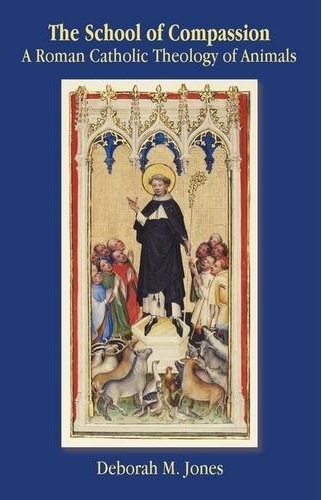 The cover of this new book by Deborah Jones, General Secretary of Catholic Concern for Animals, depicts Anthony of Egypt (anachronistically garbed) blessing the animals, the poor, and the sick. It is significant that the saint evidently views them all as equally deserving of his compassionate attention. Likewise, in this book a strong case is made that such care is a legitimate concern for the world’s Catholics. In terms of membership numbers alone – over one billion worldwide - an increased sympathy and interest on the part of adherents of the faith would, the author points out, have a considerable impact on the way animals are treated.
The cover of this new book by Deborah Jones, General Secretary of Catholic Concern for Animals, depicts Anthony of Egypt (anachronistically garbed) blessing the animals, the poor, and the sick. It is significant that the saint evidently views them all as equally deserving of his compassionate attention. Likewise, in this book a strong case is made that such care is a legitimate concern for the world’s Catholics. In terms of membership numbers alone – over one billion worldwide - an increased sympathy and interest on the part of adherents of the faith would, the author points out, have a considerable impact on the way animals are treated.
Deborah Jones begins with an overview of the religious traditions pre-dating Christianity, analyses their various pronouncements on animals and, via biblical evidence, leads on to the Catholic theologians such as Thomas Aquinas; saints – not merely Francis of Assisi and Philip Neri, but (my favourite) Martín de Porres in South America, who cared for both sick people and for animals - and the teachers and lawmakers whose stance has established the current mindset which has influenced so many of us who have a Christian background.
In her chapter entitled "The British Catholic Tradition," Deborah Jones describes how, in the 1920s, a group of lay and clerical English Catholics met to discuss animal welfare and that in 1935, they formed the Catholic Study Circle for Animal Welfare, now called Catholic Concern for Animals.
We are led systematically through the Catechism of the Catholic Church, discovering how every relevant paragraph has contributed to the thinking which, by and large, with some honourable exceptions, has relegated other animals to an inferior and often wholly insignificant role. Later, the author will develop her own thinking of how a more compassionate and respectful view can be integrated into Catholic theology. She sets out practical suggestions for how our fellow beings in all the spheres in which they are exploited--farming, vivisection, entertainment, et cetera--might be more ethically treated.
I found the book very readable and informative. To highlight a few points:
Having understood the name Pelagius to mean only a thinker whose beliefs were considered heretical, I was happy to learn that he wrote: ‘There is no creature on earth in whom God is absent…When God pronounced that his creation was good, it was not only that his hand had fashioned every creature: it was that his breath had brought every creature to life…’
Referring to the animals, the Catechism states: He surrounds them with his providential care. Deborah Jones highlights that this “echoes the writings of an early Dominican writer, for long thought to have been Thomas Aquinas himself:
‘ . . . it is God’s custom to care for all his creatures, both the greatest and the least. We should likewise care for creatures, whatsoever they are, in the sense that we use them in conformity with the divine purpose, in order that they may not bear witness against us in the day of judgment . . . ”
Many Christians struggle with the word ‘dominion’ in Genesis. A frequent, more positive synonym offered is ‘stewardship’, yet there is an interesting objection to it raised in this book. The environmentalist Edward P. Echlin is quoted as saying that stewardship ‘lends itself to a detached and manipulative view of creation’. Our author also makes the point that ‘steward’ is never used in the Bible in association with nature.
The research Deborah Jones has done regarding the disproportionately high representation of women in the animal rights and welfare movement is of great interest. Correspondingly, her evaluation of the apparent lack of interest – even hostility - of many of the Catholic clergy towards other sentient beings leads her to conclude that education as traditionally carried on in a single-sex environment is not conducive to the development of a more compassionate understanding of and empathy with vulnerable creatures. Such empathic understanding is something with which a woman's mind feels freer to identify.
Andrew Linzey has written the Foreword to the book on request; and indeed Deborah Jones is very generous to the achievements of the Anglican denomination in describing, for instance, their part in the founding of the RSPCA.
I view this as an extremely important work. Let us hope that it is read in many Catholic and other parishes by those who are in a position to influence thinking and action to benefit our fellow beings, God’s beloved creatures too.
--Marian Hussenbux, Quaker Concern for Animals
http://www.quaker-animals.org.uk
Book Review: Hope for Animals and Their World
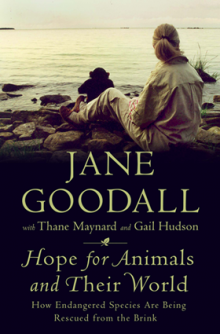 Hope for Animals and Their World - How Endangered Species Are Being Rescued from the Brink. By Jane Goodall, with Thane Maynard and Gail Hudson. New York and Boston: Grand Central Publishing, 2009. Illustrated. 392 pages, hardcover. $27.99
Hope for Animals and Their World - How Endangered Species Are Being Rescued from the Brink. By Jane Goodall, with Thane Maynard and Gail Hudson. New York and Boston: Grand Central Publishing, 2009. Illustrated. 392 pages, hardcover. $27.99
This extraordinary and life-giving book tells the story of how several species of animals (and a few plants) are being saved from extinction. The chapters are grouped according to the degree of endangerment.
Part One, "Lost in the Wild," tells of five mammals and one bird who were already officially extinct in their natural habitat. Their restoration meant programs of captive breeding, followed by reintroduction into the wild. This has not been as easy or as simple as it sounds. The rescuers had to contend with hardened bureaucracies and several natural and unnatural problems. Those rescued include the Black-footed Ferret (a lovely beast whom I have met in person), the Mala or Rufous Hare-Wallaby, and the California Condor. A fascinating and uplifting story and a beautiful color photograph are provided for each creature.
Part Two, "Saved at the Eleventh Hour," tells the stories of those animals who (unlike those in the first part) did not quite become extinct in the wild, but came close, and were saved only by heroic efforts. The creatures of this section include the Golden Tamarind, the American Crocodile, the Peregrine Falcon, the American Burying Beetle, and the Gray Wolf.
The American Crocodile was a surprise; I had mistakenly thought crocs lived only in Africa and Asia, while America only had alligators. There is an astonishing story here of how biologist Frank Mazzotti gave mouth-to-mouth to a baby crocodile nearly dead from an attack by a big ferocious crab, and saved the life of the poor little creature. Most people (including me) would be very reluctant to do this.
The chapter on the American Burying Beetle discusses the problem of people who are opposed - sometimes very vocally - to spending effort, time or money on preventing the extinction of a creature who is "just" an insect, a lowly bug. Others have disagreed; the great naturalist Joseph Banks said the Almighty must be "inordinately fond" of beetles, to have created them in such great numbers, and in such a plethora of species. Rabbi Moses Cordovero held that to have contempt for any creature is to have blasphemous contempt for the work of their Creator. And I myself have twice had deep and beautiful spiritual experiences in the company of beetles and, I believe, with their help.
Jane Goodall and her colleagues defend the Burying Beetle not by religious arguments such as these, but by pointing out the ecological usefulness of this being. "If we were to lose this crucial carrion beetle, ants and flies could reach epidemic proportions." So it is in our own enlightened self-interest to prevent the extinction of this beetle , and of all creatures whose work includes disposing of carrion, dung, etc. We need them.
The chapter on tortoises has a brief appendix on tortoises of another species. One of them was saved from despair, maybe from death, by the love and friendship of a small black cat (page 126). (Little black cats are my favorite creatures in all creation, so I was happy to read this.)
Part Three, "Never Giving Up," covers beings who "have been saved from toppling into the abyss of extinction but ... have not yet been reestablished in the wild. These include the Iberian Lynx, the Bactrian Camel, and the Giant Panda. There are over a million domesticated, i.e. enslaved, Bactrians, but those running wild and free on the steppes of Central Asia are fewer than a thousand.
Part Four deals with island birds, who have special problems: e.g., the Black Robin, Abbott's Booby, and the Blue and Gold Macaw of Trinidad. There were only nine Black Robins ("a friendly little bird") in the whole world in 1976, in a tiny island in the Pacific. Thanks to the wise and heroic efforts of Don Merton, there are now over 200 in two islands. Blue and Gold Macaws exist in great numbers in South America, but had become extinct in the island of Trinidad. They have now been reintroduced.
Part Five, "The Thrill of Discovery," is subdivided into three sections, "Species still being discovered," "Species believed extinct and recently found," and "Ancient species recently discovered." The first section contains the amazing story of an underground cave in Israel with water holding creatures from 5 million years ago. Creatures 60 million years older than that, and as old as the dinosaurs, are presented in the final chapter: the Coelacanth and the Wollemi Pine.
The final division of the book, Part Six, "The Nature of Hope" has just two chapters. In the first, Jane Goodall tells stories of the restoration and healing of eco-devastated regions. The last chapter is devoted to the reasons for saving endangered species. Finally, a very important Appendix, "What you can do," contains e-mail addresses, postal mail addresses, and helpful suggestions.
I strongly recommend this book for all those who love animals and care about their state in the wild. I would like to see a version for very young readers, with all the color photographs but a simplified text.
--Benjamin Urrutia
Pioneer: Philip Neri, 1515-1595
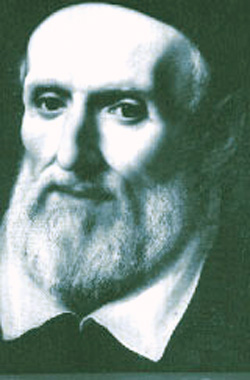 Of all the saints on the Christian or any other calendar, there are few with whom I would rather spend a sociable evening than Philip Neri. Others may be more powerful intellectuals, profounder mystics, or more heroic missionaries, but Philip Neri (who also had these gifts) was perhaps unequaled in one area: he was delightful company. Like the saint of Assisi, Philip had charm. By all accounts, he was continually overflowing with laughter, kindly jokes, and love stemming from an unquenchable inner joy. People, especially young people were drawn to him, and by his winning ways he brought many to a deeper love of the divine Source of his own happiness. He liked to play with children; animals too loved to be with him, perhaps also in their own way coming to love God through the saint.
Of all the saints on the Christian or any other calendar, there are few with whom I would rather spend a sociable evening than Philip Neri. Others may be more powerful intellectuals, profounder mystics, or more heroic missionaries, but Philip Neri (who also had these gifts) was perhaps unequaled in one area: he was delightful company. Like the saint of Assisi, Philip had charm. By all accounts, he was continually overflowing with laughter, kindly jokes, and love stemming from an unquenchable inner joy. People, especially young people were drawn to him, and by his winning ways he brought many to a deeper love of the divine Source of his own happiness. He liked to play with children; animals too loved to be with him, perhaps also in their own way coming to love God through the saint.
Regrettably, little of this merry-heartedness shows in paintings of him.
The same year that Teresa of Ávila was born, Philip Neri was born in or near Florence, the son of an impoverished notary and his short-lived wife. Even as a child he was drawn to animals; it is reported that, on visiting a farm at age six, he made a point of greeting all the animals there. Unfortunately, he also jumped on the back of a donkey, injuring himself when he slid off backwards and grabbed the tail, causing the beast to fall on him. His devoted father and stepmother were naturally alarmed, but no harm came of the incident. (My feelings of kinship with Philip may be partly due to the fact that a similar experience, with a mule, came to me as a child on a visit to an uncle's farm, and I had to be taken to a doctor with bruises on my backside and my dignity.)
After education by Dominicans in Florence, Philip briefly tried the career of a businessman with a wealthy uncle in Naples who wanted to appoint him as his heir. But Philip soon realized this life was not for him. At a shrine he experienced a deep religious conversion; then, feeling called to Rome, he proceeded to the Eternal City without plans or means. For some five years he lived a rather hermit-like existence there in poverty, tutoring and studying philosophy and theology. Then, coming out of his quasi-seclusion, he informally began what is called in the Roman Catholic church an Apostolate. Deeply concerned about the corruption and worldliness of church and society, Philip talked to young people on street corners and in casual get-togethers, and visited the sick in hospitals, always using his extraordinarily charismatic personality to encourage all he encountered toward a deeper spiritual life.
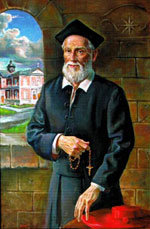 In time he and his closest disciples began living communally. Out of this movement slowly grew the Congregation of the Oratory, the community for which Philip is known. Not a monastic order in the traditional sense, it is a fellowship of priests and brothers living together without formal vows, dedicated to active pastoral work in the world. (The music sung in their worship services later evolved into the musical form oratorio.) Philip was himself ordained priest in 1551, and quickly became known for his remarkable gifts of spiritual counseling, both in the confessional and in conversations with the inwardly troubled. Many, from cardinals to the desperately poor, made their way to his door.
In time he and his closest disciples began living communally. Out of this movement slowly grew the Congregation of the Oratory, the community for which Philip is known. Not a monastic order in the traditional sense, it is a fellowship of priests and brothers living together without formal vows, dedicated to active pastoral work in the world. (The music sung in their worship services later evolved into the musical form oratorio.) Philip was himself ordained priest in 1551, and quickly became known for his remarkable gifts of spiritual counseling, both in the confessional and in conversations with the inwardly troubled. Many, from cardinals to the desperately poor, made their way to his door.
In the course of his ministry, he manifested remarkable visionary, telepathic, precognitive, and healing powers, which were always dedicated to service. Relative success and fame -- he was recognized as a saint even his own time -- did not diminish the selfless radiance by which he won souls through the power of his inner joy and love, rather than righteous anger or fear. He seemed always exuberant and gentle. Believing in non-violence to all creatures and personally austere, he lived on a vegetarian diet of bread and water, olives and vegetables.
 Many are the stories of his concern for animals. Seeing someone step on a lizard, he cried out, "What has he ever done to you?" Once seeing a butcher wound a dog with a knife, the saint could barely contain himself, on this occasion having great difficulty in maintaining his usual good cheer. If a bird came into his room, he would make sure the windows were open for the creature to escape. His beloved cat was well known to all of Rome, and Philip would send his disciples of noblest blood, as an experience in humility, to take food to this animal friend.
Many are the stories of his concern for animals. Seeing someone step on a lizard, he cried out, "What has he ever done to you?" Once seeing a butcher wound a dog with a knife, the saint could barely contain himself, on this occasion having great difficulty in maintaining his usual good cheer. If a bird came into his room, he would make sure the windows were open for the creature to escape. His beloved cat was well known to all of Rome, and Philip would send his disciples of noblest blood, as an experience in humility, to take food to this animal friend.
One of the most famous later member of Philip Neri's Oratory was John Henry Newman, who was also know for his kindness to animals, and who preached a sermon (see JH Newman in PT 16) eloquently denouncing cruelty to them. Here is a prayer Newman addressed to the saint:
Philip, my glorious Advocate, teach me to look at all I see around me after thy pattern, as creatures of God.
Let me never forget that the same God who made me, made the whole world and all animals that are in it.
Give me the grace to love all God's works for God's sake, and all men for the sake of my Lord and Savior who has redeemed me on the Cross.
--Robert Ellwood
Poetry: William Shakespeare
The following passage from Hamlet presents a variant on the idea of animal-related supernormal activity during Christmastide. The bird who normally sings at dawn sings all night long, but instead of ghosts becoming more prevalent during this period, they are prevented from walking at night. Even the rational Horatio claims to believe it--in part.
Horatio:
. . . . I have heard
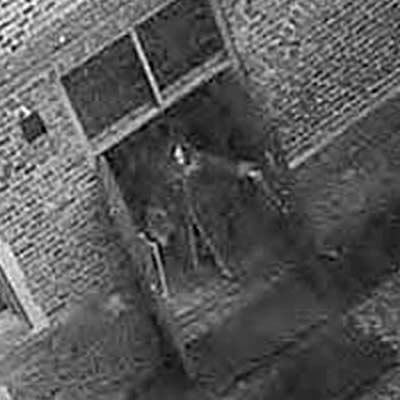 The cock, that is the trumpet to the morn,
The cock, that is the trumpet to the morn,
Doth with his lofty and shrill-sounding throat
Awake the god of day; and, at his warning,
Whether in sea or fire, in earth or air,
The extravagant and erring spirit hies
To his confine . . . .
Marcellus:
It faded on the crowing of the cock.
Some say that ever 'gainst that season comes
Wherein our Saviour's birth is celebrated,
The bird of dawning singeth all night long:
And then, they say, no spirit dares stir abroad;
The nights are wholesome; then no planets strike,
No fairy takes, nor witch hath power to charm,
So hallow'd and so gracious is the time.
Horatio:
So have I heard and do in part believe it.
But look, the morn, in russet mantle clad,
Walks o'er the dew of yon high eastward hill . . . .
The photo, taken at England's Hampton Court, a former royal residence, seems to show a ghostly figure in 17th-century livery closing a set of double doors.
The Darkling Thrush
("By the Century's Deathbed")
I leant upon a coppice gate
When Frost was spectre-gray,
And Winter's dregs made desolate
The weakening eye of day.
The tangled bine-stems scored the sky
Like strings of broken lyres,
And all mankind that haunted nigh
Had sought their household fires.
The land's sharp features seemed to be
The Century's corpse outleant,
His crypt the cloudy canopy,
The wind his death-lament.
The ancient pulse of germ and birth
Was shrunken hard and dry,
And every spirit upon earth
Seemed fervourless as I.
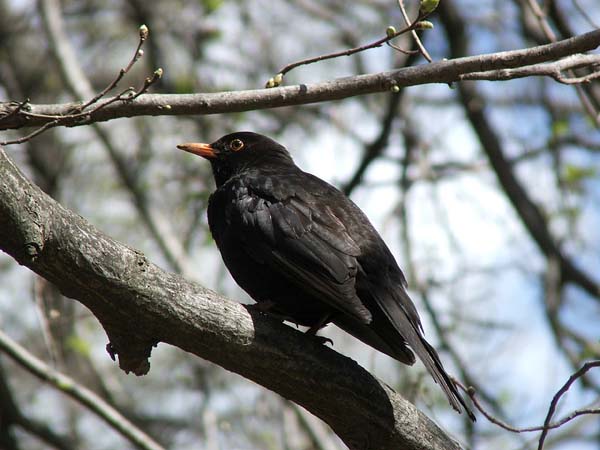 At once a voice arose among
At once a voice arose among
The bleak twigs overhead
In a full-hearted evensong
Of joy illimited;
An aged thrush, frail, gaunt, and small,
In blast-beruffled plume,
Had chosen thus to fling his soul
Upon the growing gloom.
So little cause for carolings
Of such ecstatic sound
Was written on terrestrial things
Afar or nigh around,
That I could think there trembled through
His happy good-night air
Some blessed Hope, whereof he knew
And I was unaware.
-- Thomas Hardy
December 31, 1900
This poem was featured in our December 2005 issue, but so fine a work can bear rereading. To the brief commentary there regarding its religious implications (See Darkling Thrush ) it may be added that the traditional Christmastide death-and-ghost theme pervades the first two stanzas. In fact all the living, even the narrator, seem to be ghostly in contrast to the powerfully vital song of the small bird.
To hear a recording of the song of the Eurasian Blackbird / Darkling Thrush, click on Blackbird .


 is available, group dancing is a wonderful way to celebrate, and many circle dances are easy to learn. "Sir Roger de Coverley," the line dance happily if clumsily done at Fezziwig's ball, is quickly learned: see instructions at Sir Roger , and a clip of the dance being performed at Dance . Singing carols around the fire as the Cratchits did is another joyous thing--and if the party site is uncooperative, one can always do without the fire!
is available, group dancing is a wonderful way to celebrate, and many circle dances are easy to learn. "Sir Roger de Coverley," the line dance happily if clumsily done at Fezziwig's ball, is quickly learned: see instructions at Sir Roger , and a clip of the dance being performed at Dance . Singing carols around the fire as the Cratchits did is another joyous thing--and if the party site is uncooperative, one can always do without the fire! 


 The cover of this new book by Deborah Jones, General Secretary of Catholic Concern for Animals, depicts Anthony of Egypt (anachronistically garbed) blessing the animals, the poor, and the sick. It is significant that the saint evidently views them all as equally deserving of his compassionate attention. Likewise, in this book a strong case is made that such care is a legitimate concern for the world’s Catholics. In terms of membership numbers alone – over one billion worldwide - an increased sympathy and interest on the part of adherents of the faith would, the author points out, have a considerable impact on the way animals are treated.
The cover of this new book by Deborah Jones, General Secretary of Catholic Concern for Animals, depicts Anthony of Egypt (anachronistically garbed) blessing the animals, the poor, and the sick. It is significant that the saint evidently views them all as equally deserving of his compassionate attention. Likewise, in this book a strong case is made that such care is a legitimate concern for the world’s Catholics. In terms of membership numbers alone – over one billion worldwide - an increased sympathy and interest on the part of adherents of the faith would, the author points out, have a considerable impact on the way animals are treated. Hope for Animals and Their World - How Endangered Species Are Being Rescued from the Brink. By Jane Goodall, with Thane Maynard and Gail Hudson. New York and Boston: Grand Central Publishing, 2009. Illustrated. 392 pages, hardcover. $27.99
Hope for Animals and Their World - How Endangered Species Are Being Rescued from the Brink. By Jane Goodall, with Thane Maynard and Gail Hudson. New York and Boston: Grand Central Publishing, 2009. Illustrated. 392 pages, hardcover. $27.99  ½ cup fair-trade cocoa powder
½ cup fair-trade cocoa powder Of all the saints on the Christian or any other calendar, there are few with whom I would rather spend a sociable evening than Philip Neri. Others may be more powerful intellectuals, profounder mystics, or more heroic missionaries, but Philip Neri (who also had these gifts) was perhaps unequaled in one area: he was delightful company. Like the saint of Assisi, Philip had charm. By all accounts, he was continually overflowing with laughter, kindly jokes, and love stemming from an unquenchable inner joy. People, especially young people were drawn to him, and by his winning ways he brought many to a deeper love of the divine Source of his own happiness. He liked to play with children; animals too loved to be with him, perhaps also in their own way coming to love God through the saint.
Of all the saints on the Christian or any other calendar, there are few with whom I would rather spend a sociable evening than Philip Neri. Others may be more powerful intellectuals, profounder mystics, or more heroic missionaries, but Philip Neri (who also had these gifts) was perhaps unequaled in one area: he was delightful company. Like the saint of Assisi, Philip had charm. By all accounts, he was continually overflowing with laughter, kindly jokes, and love stemming from an unquenchable inner joy. People, especially young people were drawn to him, and by his winning ways he brought many to a deeper love of the divine Source of his own happiness. He liked to play with children; animals too loved to be with him, perhaps also in their own way coming to love God through the saint. In time he and his closest disciples began living communally. Out of this movement slowly grew the Congregation of the Oratory, the community for which Philip is known. Not a monastic order in the traditional sense, it is a fellowship of priests and brothers living together without formal vows, dedicated to active pastoral work in the world. (The music sung in their worship services later evolved into the musical form oratorio.) Philip was himself ordained priest in 1551, and quickly became known for his remarkable gifts of spiritual counseling, both in the confessional and in conversations with the inwardly troubled. Many, from cardinals to the desperately poor, made their way to his door.
In time he and his closest disciples began living communally. Out of this movement slowly grew the Congregation of the Oratory, the community for which Philip is known. Not a monastic order in the traditional sense, it is a fellowship of priests and brothers living together without formal vows, dedicated to active pastoral work in the world. (The music sung in their worship services later evolved into the musical form oratorio.) Philip was himself ordained priest in 1551, and quickly became known for his remarkable gifts of spiritual counseling, both in the confessional and in conversations with the inwardly troubled. Many, from cardinals to the desperately poor, made their way to his door. Many are the stories of his concern for animals. Seeing someone step on a lizard, he cried out, "What has he ever done to you?" Once seeing a butcher wound a dog with a knife, the saint could barely contain himself, on this occasion having great difficulty in maintaining his usual good cheer. If a bird came into his room, he would make sure the windows were open for the creature to escape. His beloved cat was well known to all of Rome, and Philip would send his disciples of noblest blood, as an experience in humility, to take food to this animal friend.
Many are the stories of his concern for animals. Seeing someone step on a lizard, he cried out, "What has he ever done to you?" Once seeing a butcher wound a dog with a knife, the saint could barely contain himself, on this occasion having great difficulty in maintaining his usual good cheer. If a bird came into his room, he would make sure the windows were open for the creature to escape. His beloved cat was well known to all of Rome, and Philip would send his disciples of noblest blood, as an experience in humility, to take food to this animal friend. The cock, that is the trumpet to the morn,
The cock, that is the trumpet to the morn, At once a voice arose among
At once a voice arose among